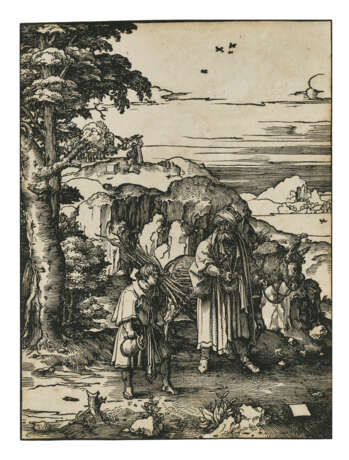ID 1303428
Lot 5 | LUCAS VAN LEYDEN (1494-1533)
Estimate value
$ 30 000 – 50 000
Abraham and Isaac
woodcut
circa 1517
on laid paper, watermark Small Shield with one Fleur-de-lys and Cross (New Hollstein 2b)
a brilliant impression of this very rare print
first state (of two)
printing very evenly, with remarkable clarity, great contrasts and depth
trimmed to or just outside the borderline
generally in good condition
Block & Sheet: 11 ¼ x 8 3/8 in. (287 x 214 mm.)
Provenance
Edwin A. Seasongood (1876-1953), New York (without his mark; see Lugt 826b); his sale, Parke-Bernet Galleries, New York, 5-6 November 1951, lot 167 ('Superb impression, certainly of the very earliest printing').
Albert W. Blum (1882-1952), Zürich & Short Hills, New Jersey; with his stamp verso (Lugt 79b); presumably acquired at the above sale; then by descent; Sotheby's, New York, Old Master Prints from the Collection of the late Dr. Albert W. Blum, 27 February 1988, lot 1209 ($ 47,300).
With Margo Pollins Schab Inc., New York.
Alan and Marianne Schwartz Collection, Detroit; acquired from the above in 1988; then by descent to the present owners.
Literature
Bartsch, Hollstein 3 (this impresion cited); New Hollstein 187
Exhibited
The Detroit Institute of Arts, Master Prints of 5 Centuries: The Alan and Marianne Schwartz Collection, 1990-91, p. 146, n. 138.
| Artist: | Lucas van Leyden (1494 - 1533) |
|---|---|
| Applied technique: | Woodcut |
| Art style: | Old Masters |
| Place of origin: | Western Europe, Europe, The Netherlands |
| Artist: | Lucas van Leyden (1494 - 1533) |
|---|---|
| Applied technique: | Woodcut |
| Art style: | Old Masters |
| Place of origin: | Western Europe, Europe, The Netherlands |
| Address of auction |
CHRISTIE'S 20 Rockefeller Plaza 10020 New York USA | ||||||||||||||
|---|---|---|---|---|---|---|---|---|---|---|---|---|---|---|---|
| Preview |
| ||||||||||||||
| Phone | +1 212 636 2000 | ||||||||||||||
| Fax | +1 212 636 4930 | ||||||||||||||
| Conditions of purchase | Conditions of purchase | ||||||||||||||
| Shipping |
Postal service Courier service pickup by yourself | ||||||||||||||
| Payment methods |
Wire Transfer | ||||||||||||||
| Business hours | Business hours
|












